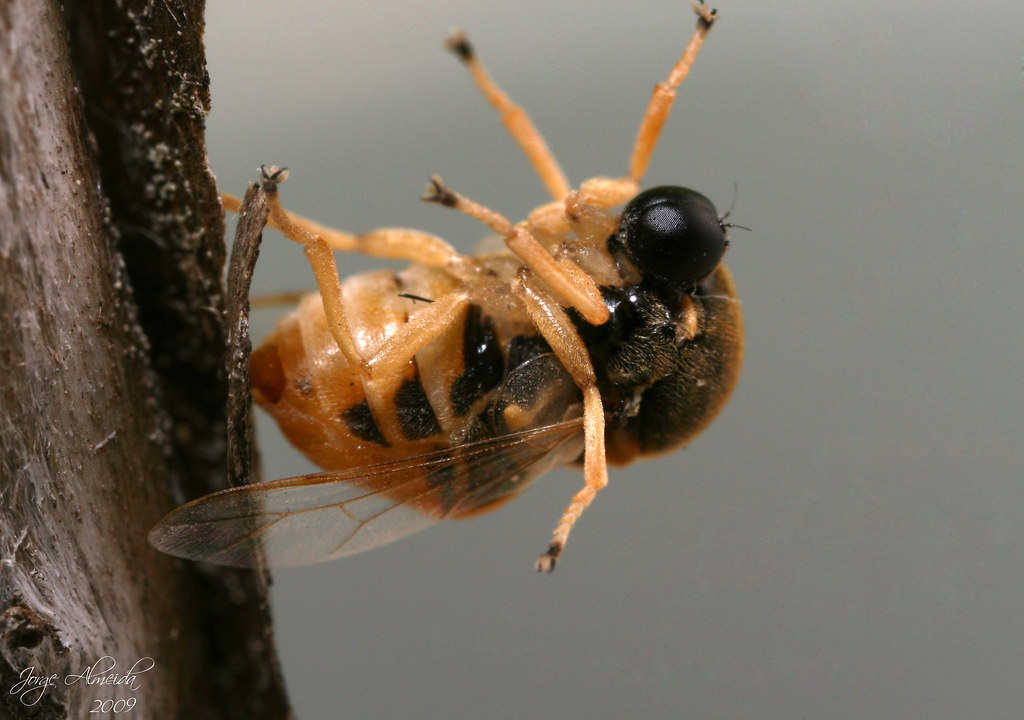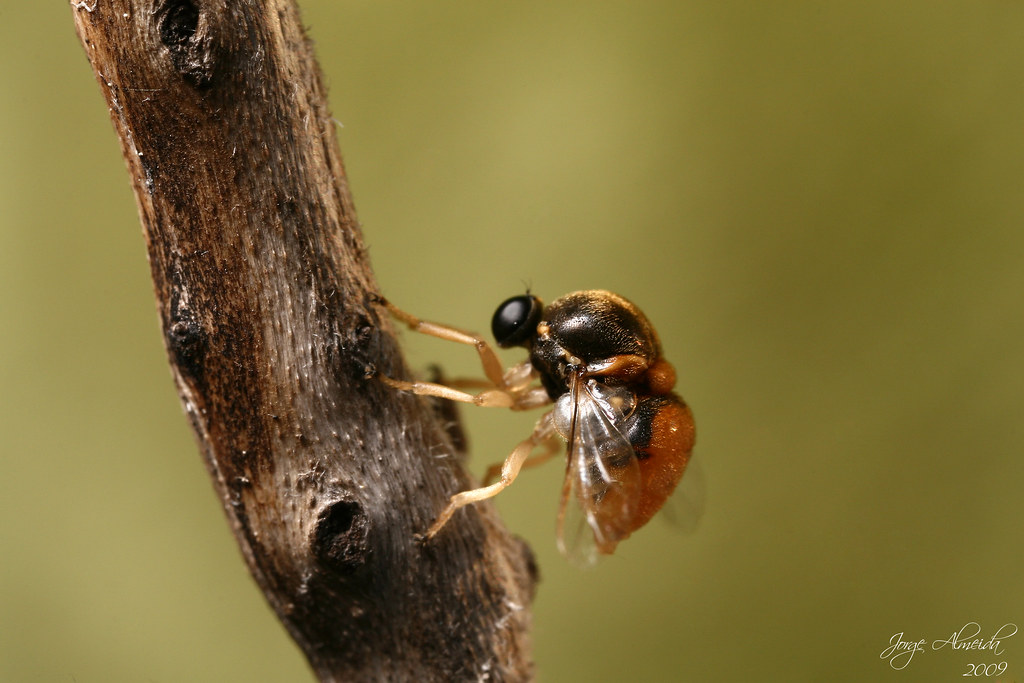Thread subject: Diptera.info :: free fall ... Acrocera orbiculus
Posted by jorgemotalmeida on 19-07-2009 22:27
#1
Hi
I have spot this morning in Serra da Estrela the amazing and fantastic Acrocera sp. (maybe an A. sanguinea? ). It was so unusual to spot over 10 acrocerids separated from each other in a radius of about 500 m. I have never found per day MORE than 3 acrocerids, but today I saw 12!!! Some acrocerids attached to my t-shirt and others to my arm. Curious that these flies tried to approach my eyes... it is an unusual behaviour that we can find in Phortica (as it feeds on tear's eyes.)
Enjoy.. the fly :) .

Edited by jorgemotalmeida on 26-07-2009 17:41
Posted by jorgemotalmeida on 19-07-2009 22:35
#2
and here more one photo.

to see it better... go to my flickr ;)
Edited by jorgemotalmeida on 19-07-2009 22:36
Posted by Nosferatumyia on 19-07-2009 22:36
#3
I had same experience in Middle Asia. They were swarming around my head when I was sitting on the edge of a gorge, an I took the by bare hands and put in a killing jar...
Posted by jorgemotalmeida on 19-07-2009 22:45
#4
:D yes. And put my feet back... and catch one by one... with this approach. :)
They were separated within some meters...
I never expected to see them in a very open land!! :| And it was windy. A soft wind, though.
I will show photos of the habitat soon. ;)
Edited by jorgemotalmeida on 19-07-2009 22:48
Posted by jorgemotalmeida on 19-07-2009 22:58
#5
what is odd (?) is the absence of any proboscis..
Posted by pwalter on 20-07-2009 10:32
#6
Hi, congratulations on the photos, what is the size of the fly?
Posted by jorgemotalmeida on 20-07-2009 10:38
#7
pwalter wrote:
Hi, congratulations on the photos, what is the size of the fly?
Thanks. :)
Very small. It has 3 mm. I have others with 4 mm - 5 mm. But this specimen on the photos has 3 mm
Posted by Rui Andrade on 20-07-2009 18:39
#8
WOW, you are a very lucky guy:).
Posted by jorgemotalmeida on 20-07-2009 23:28
#9
You are even more, Andrade. You spotted an alive Astomella hispaniae! And you'll have a new .... soon.. ;)
Edited by jorgemotalmeida on 20-07-2009 23:30
Posted by jorgemotalmeida on 21-07-2009 00:42
#10
this is the place where I spottted Acrocera. Also we can find there Baumhaeuria (rare), Chaetogena, Bombylius discolor, and some cows. :s lol
the photo is not mine. It was in google images. It is a small one. Just to show the habitat place. ;)
Edited by ChrisR on 22-07-2009 08:53
Posted by Andre on 21-07-2009 08:26
#11
It is known behaviour of Acroceridae... And indeed it is still unknown what they feed on, if ever! Also to find the hosts is still intruiging. Good that you collected some.
Maybe Theo Zeegers can be of any help for ID?
Posted by jorgemotalmeida on 21-07-2009 09:50
#12
André I will rear some lycosid spiders. Let's go see if I can get some acrocerids. But it is a hard task! Is there any possibility that they can parasite beetles? (that place has a huge number of coleopterans!)
In that zone there is Lycosa fasciiventris, Alopecosa simoni (extremely beautiful spider!), Aelurillus v-insignitus, Thanatus lineatipes... and so on. ;)
Posted by Zeegers on 21-07-2009 19:43
#13
Yes, looks like A. sanguinea, which is synonym of trigramma (one is male, other female).
sanguinea is the valid name.
Theo
Posted by jorgemotalmeida on 21-07-2009 21:26
#14
Thanks, Theo.
A pity that Isidro's photos are not available. He photographed an Acrocera sanguinea last year. It seems that there is a considerable variability among Acrocera sanguinea.
Posted by paqui on 21-07-2009 21:44
#15
Its thorax´s stripes were a fuzz for me before knowing they had "become" the same species. Pictures and keys at Faune de France pointed "undoubtfully" to A. trigramma :|
Congratulations, Jorge, your pics are very good (not just thes 2) :)
Posted by jorgemotalmeida on 21-07-2009 22:33
#16
Thanks, paqui. I will upload some new photos tomorrow to show the dorsal view. :)
Posted by ChrisR on 22-07-2009 08:57
#17
It looks like amazing habitat - great for hill-topping flies :) Before you leave just remember to check your pooter and your tubes to make sure that you don't bring back any cows! ;)
Posted by jorgemotalmeida on 24-07-2009 19:49
#18
here are the photos otaken by Isidro Martinez in Zaragoza - Spain. It seems that Acrocera sanguinea can have a high variability in the scutum and in the abdomen. So here the photos to compare with mine.
Edited by jorgemotalmeida on 24-07-2009 20:01
Posted by jorgemotalmeida on 24-07-2009 19:49
#19
another from Isidro (who kindly granted to me the photos)
Posted by jorgemotalmeida on 24-07-2009 19:50
#20
another from Isidro
Posted by jorgemotalmeida on 24-07-2009 19:50
#21
another from Isidro.
Edited by jorgemotalmeida on 24-07-2009 19:58
Posted by jorgemotalmeida on 24-07-2009 19:52
#22
now, here we can see the same specimen as the first photos. And then I will show another Acrocera I spotted in the same place with some differences.
Posted by jorgemotalmeida on 24-07-2009 19:53
#23
another from dorsal view... compare with the Isidro's photos (in page 1). The same species and a high variability in the specimens.
Posted by jorgemotalmeida on 24-07-2009 19:54
#24
now, a different specimen I caught in the same place. It has some differences in comparation with the first specimen I showed and with Isidro's photos.
Posted by jorgemotalmeida on 24-07-2009 19:55
#25
and the last...
Posted by jorgemotalmeida on 24-07-2009 20:00
#26
So, this shows that Acrocera sanguinea has a great variability. Not so much as the Cyrtus gibbus (the differences resides in the patterns of the abdomen.)
I would like to hear opinions about these 3 specimens. They look rather interesting. (ok... opinion a little biased :) )
The first photo (specimen) shows a very reddish abdomen than yellowish/beije. The specimen of Isidro has a remarkable pattern on the scutum. The specimens of Serra da Estrela has the scutum all black. Also among the specimens of Serra da Estrela there are differences in size that can be comparable! 3 mm to 6 mm. And differences on abdomen can be seen as well. The last specimen has yellowish hues in the abdomen and there are no triangular spots visible. The first specimen I showed has a very weak triangular spot.
Edited by jorgemotalmeida on 25-07-2009 08:59
Posted by jorgemotalmeida on 25-07-2009 13:37
#27
i was seeing the Bei Bienko's keys and I found another Acrocera... Acrocera globula that fits better in the specimens I caught... Now Acrocera globula is a synonym of Acrocera orbiculus
http://www.faunae...p?id=59493
The Acrocera of Isidro is *really* an Acrocera sanguinea.
Unfortunately the description of A. orbiculus (globula) in Bei-Bienko by Emilia Narchuk is rather poor.
Could be the first specimen really an Acrocera orbiculus?
Posted by jorgemotalmeida on 25-07-2009 13:40
#28
see here:
Posted by Zeegers on 26-07-2009 17:09
#29
The wing venation is different. This is definitely not sanguinea but Acrocera orbiculus, first a male (scutellum yellow), then the female (dark). Also a very variable species.
We could already have seen it in the first pic, but I missed it.
Theo
Posted by jorgemotalmeida on 26-07-2009 17:41
#30
:D great, Theo! I have ALSO found more two today!!!! :D
And a new genus for Portugal as well... :D Soon I will give more info :)

